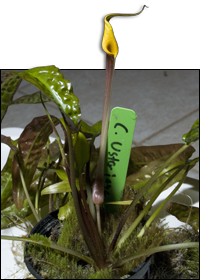
Horticulture Awards Program
[Editor’s note: This is a very old HAP description that I recopied circa 1995 from materials that were
clearly dating back to the 1980’s or even earlier. The HAP chair gets to adjust and modernize rules at their
discretion, so these old rules may not accurately represent what is used today. -- EO]

Cryptocoryne usteriana, emergent spathe. Good for 25 points!
Requirements
- A doubling of the original amount of plant material is necessary
to receive credit for reproducing bunch plants or floating plants.
- The reproduction of one separate plant is sufficient in the case
of plants that produce runners (like Amazon swords).
- Plants produced sexually must be large enough to identify as the
same as the parent plant.
- Ferns and plants reproduced by rhizome division (such as
Anubias) must be free of the parent plant and at least 1/4 the
size of the parent plant.
- Propagation by seed points will be awarded in addition to points
awarded for flowering.
- Points for flowering of plants may be awarded for either
submerged or emersed specimens.
Additional Criteria
- Points are awarded for only two reproductions of each
species.
- Seeds must have been propagated from the breeder’s own plants.
- Reports are submitted electronically here.
- The aquarist must be a member in good standing (dues paid) of
the Greater Seattle Aquarium Society.
- All participants are encouraged to give a short oral report of
the details involved in propagation of plants that have been submitted
for points. An article to be published in the monthly bulletin would
be greatly appreciated for any plants, especially in class D or E.
- Propagations and/or tanks should be witnessed by a GSAS member.
A photograph is an acceptable alternative.
Awards
A certificate will be awarded to recognize your accomplishments at the
following levels:
- Novice Plant Breeder
- 50 points, any class
- Aquatic Horticulturist
- 100 points, max 50 in class A
- Advanced Aquatic Horticulturist
- 200 points, at least one in class C,E
- Expert Aquatic Horticulturist
- 300 points, oral or written report
- Master Aquatic Horticulturist
- 400 points, write at least one report for the bulletin and present
a program at a general meeting
Point Classification for Plant Species
Class A --- 5 points
- All bunch plants or floating plants unless otherwise mentioned
- Salvinia (floating fern)
- Azolla (fairy moss, actually a floating fern)
- Eichhornia crassipes (water hyacinth)
- Pistia stratiotes (water lettuce)
- Vesicularia dubyana (Java moss)
- Lemna sp. (duckweed)
- Hygrophila, Nomaphila, Synnema
(green hygro, giant hygro, wysteria, etc.)
- Ceratophyllum (hornwort)
- Limnophila (ambulia)
- Bacopa
- Potamogeton (pondweed)
- Najas
- Utricularia (bladderwort)
- Hydrilla
- Myriophyllum (milfoil, foxtail)
- Nitella sp. (hairgrass)
- Elodea/Egeria (anachris)
Class B --- 10 points
- Riccia fluitans (crystalwort)
- Valisneria sp.
- Sagittaria sp.
- Hydrocotyle (pennywort)
- Ceratopteris (water sprite)
- Microsorum pteropus (Java fern)
- Echinodorus tenellus, et. al. (pygmy chain swords)
- Rotala sp.
- Isotes sp.
- Elocharis (spike rush)
- Didiplis diandra
- Lobelia cardinalis
- Ludwigia sp.
- Cabomba sp.
Class C --- 15 points
- Cryptocoryne sp.
- Aponogeton sp. except A. madagascareiensis
- Barclaya longifolia
- Anubias sp.
- Echinodorus sp. (except for pygmy chain swords)
- Nymphaea, Nuphar, Nymphoides (water lily, pond lily,
banana plant)
- Lagenardra sp.
- Samolus sp. (water cabbage)
- Ammania sp.
Class D --- 25 points
- Aponogeton madagascariensis (M. lace plant)
- Ottelia alismoidees
CLASS E --- special, 25 points
- Flowering of any plant (two per species allowable)
- Propagation of any plant from seeds produced by an aquatist’s
plant (two propagations per species are allowable)
Propagation of a plant that is a first by a GSAS member [removed by HAP chair due to difficulty of verifying!]
- Donation of any plants to GSAS for auction
